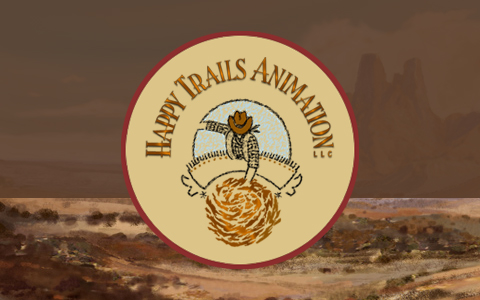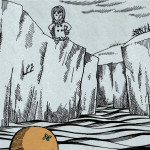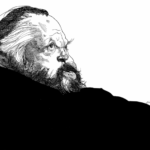Andy Collen talks about filmmaking and the short animated film ‘Winter,’ recent winner of the Boston Motion Picture Award.
Animation has taken many forms over the past century. “Snow White,” “Pokemon,” and “Toy Story” have defined the art form and each taken it in new directions. A new short film by Happy Trails Animation, entitled “Winter,” has once again proven animation to be a compelling and magical medium. Winner of the Boston Motion Picture Award, “Winter” gives a glimpse into the heart of a little girl who is caring for her ailing mother.
Andy Collen and Amy Blumenstein-Collen founded Happy Trails Animation in 1991. “Winter” has received a number of awards at film festivals around the globe including Portugal, Australia, Italy, and the United Kingdom. Running only 11 minutes, “Winter” has been acclaimed across America in Portland, Houston, Denver, and Memphis.
In a recent interview with director Andy Collen, one half of the husband-wife team that makes up Happy Trails Animation, he spoke of “Winter” and the changes animation has seen since its inception.
Andrea Maxwell: How long have the others at Happy Trails Animation been with you?
Andy Collen: Happy Trails Animation is built as an independent studio, which means freelance. We have had many very talented folks through our doors. We tend to mix things up — we have artists who have worked everything from “Brother Bear” to “Beauty and the Beast” — or even old Captain Crunch and Raid commercials. Happy Trails was created by the both of us in 1991 because we had been freelancing at a few local studios and felt that we could do better… I mean in efficiency. Funny how when you come from the old school way of thinking in filmmaking and your first animation computer is an Amiga, you are forced to use your brain and find creative ways to… make things do more than what they are meant for.
AM: How long did the film take to create?
Collen: That’s a hard question. Once “Winter” was started, whenever a paying gig would come through it would get pushed aside. I would say that it really took us 2 years to finish the filmmaking.
AM: Where did the idea for “Winter” come from?
Collen: I have always been a fan of Edward Gorey and wanted to create a film in that illustrative style. The basis for this film comes from a dream Amy had about her mother who was in the early stages of dementia. We both have our own ideas and meanings for this film… but I guess the one thing that we agree on is that having the young girl as the main character as opposed to a boy helps to promote an innocence. Our film is made up of many creative visions and life experiences that together make up the heart of this film.
AM: What is appealing about telling a story through the eyes of a child as “Winter” does?
Collen: I feel that when you use a child as a means to tell a story as in “Winter” or “The Sixth Sense” the director is trying to get straight to the essence of the message. A child is innocent and very raw. They are experiencing life as it comes forth…not sure what is happening and trying to make sense at the same time. We wanted the metaphor of that “we are all little children bouncing through life.” Really no matter how educated, rich, poor — whatever things come up every day that we need to figure out how to deal with, and for that instant we are all little children. I believe that the Dalai Lama talks about living in this raw world. I think it is a place where observations are accepted and then realized.
AM: Looking at some of your other work, the animation styles vary greatly. Do either of you have a favorite style of filmmaking?
Collen: We were once told by a local ad agency after showing our work, “Nice. So what do you do?” To which we replied “We animate.” I think that it is the love of movement and creating a certain emotion from any media that made both of us fall in love with animation. To us it is all about texture and feelings. I think we also want to create work that interacts with the audience — to inspire conversation, to inspire clients and the public. We once received a phone call from a company in Fullerton, California where they had tried using live action for an emotional topic but it made their test audience uneasy. They felt that animation could cut across the line that live action had problems with because of the subject matter. So they asked us if we had any boards that we could shape to this client. “Yes,” we said. Needless to say, we did the job and their client got such an overwhelming response to the ad that their phone system crashed. They had to hire two new staff members to answer phones. That is why we do what we do — reach into audiences and get a wonderful response. We do not really have a favorite style and so this is a hard question to really answer.
AM: How do you decide what style of animation works best with the particular story you’re trying to tell?
Collen: Well for us the story and images comes first and then we think about the emotions of what we want this film to relate to the audience. For instance, “Hero Sandwich” was a film we made with colored sand. In fact, ours was the first film to use colored sand. Sand had been animated over the years, but only as front-light or back-light and it was always just plain sand color. Besides the cool style, we wanted to bump it up a notch and do something that other studios could not mimic easily. After all, who wants sand in their studio? Nut jobs like us I guess. So, we developed an organic style to match the quality of our unscripted soundtrack. Our subject matter was handicapped parking and our story involved social interaction between humans, so we wanted this to have a very human quality, nothing too commercial, which is funny because the style fit the story so well that some festivals thought our film was a PSA and wouldn’t show the film. They seemed to think that this was a commercial adventure. No! Not so. So we just took that as a compliment, even though we were kicked out of some fests. (Laughs). Win some, lose some.
AM: Can you walk me through what each of you typically does on a film? Where do your two jobs overlap?
Collen: I am the technical director and overall director. Amy is the art director and production manager. Together we develop a look that we both like and then she, if it is hand inked, will oversee the art prep stuff. I figure out how this is going to finally be put together and she helps take that knowledge and make the art work for me. Everything is committee — she and I.
AM: What are the ups and downs of working so closely together?
Collen: We’ll never stop talking animation. We are always talking about what we can do with this new software or computer system. We also seem to take work home so it means that we are constantly in the world we work in — we do not leave. So I guess you have to love it or else we would be in trouble. I guess you could say that the ups and downs are that when personal issues come up we have to deal with them right away. Stress for deadlines can affect dinner if you know what I mean.
AM: What are the greatest challenges while making a film?
Collen: I think that when you work on a film that takes over a year one of the hardest things to deal with is consistence. When you have different animators working with different scenes, flow seems to differ. With this film we pretty much had one dude. He was awesome and stuck with this project to the end. In fact he was the final push to get the film done and in the can. The greatest challenges in this film were what we refer to as the money shots. Most people sort of spread these out in their film. But us no. We had to put them in the beginning. This is the long slow pan to the window were we met our main character and then as we get a glimpse into the room where her mother is. We wanted to show bits and pieces so that as a viewer you slowly begin to feel for this girl. I would say that the hardest scene to figure out was the room pan. It really is an Esheresque type of creation. The hardest inking scene was by far the intro — all those trees and then the building. Wow. All this is about 80 percent Amy.
AM: What set this particular film apart from others for you both?
Collen: Well I think it is the longest short we have ever done. I also think the fact that this has no verbal devices to help explain animation. Lulls where audiences might get lost we had to flow. The images and the music had to be our words. We wanted to create a film that no matter what country it was shown in anyone in the audience all understood the same message. We wanted to make a film that communicated without actually communicating, if you know what I mean.
AM: Watching the film, I was amazed at how real it felt. It was such a difference from what we’ve lately been told is “animated.” Is each of you a bigger fan of animation that calls attention to the fact that it’s animated (like many cartoons do) or animation that is as realistic as possible?
Collen: Yes! We are very big Hayao Miyazaki fans and so we wanted this film to have a bit of his magical feel. He has a special way of timing and image flow and that is what we wanted this film to have. It is very slow and very inviting. In reality this is almost one big money shot. (Laughs).
AM: Why use color so sparingly in “Winter?”
Collen: We feel that some people these days use color for eye candy. We wanted our audience to live for a few minutes with the little girl. We wanted the look to not be daunting like the message. We wanted a look and feel that would be a yin and yang to the story, if that makes sense. We also wanted to have the true color to have a meaning other then a distraction. So the nail polish, the orange and the crocus are the objects that we chose to give the power of color to. The orange is nourishment and something that the girl picks for her self, maybe a comfort food or something. The nail polish represents that the girl still trying to reach and connect to her aging mother. The crocus speaks to the fact that another winter has passed and spring is on the way — no mater what happens life goes on.
AM: Do you look forward to or dread the day when animation becomes so lifelike we won’t need human actors?
Collen: As an artist I believe that there is a time and place for animation and then there is a place for disdained belief, which is what I think you are talking about. I think the fascination with this 3D/Live action is in part a sense of reality that doesn’t relay exist. 3D will in my mind never replace live, real breathing people. It is, however, magical and brings live action into a real Dali-esque world. This is a great effect for things like tigers and stuff. I do understand wanting to find a way to shoot a film using Bengal tigers and not have someone’s neck bit off. (Laughs). For quick cutaways and inserts most viewing public can’t tell the difference. It saves a lot on a lot of film and the exact angle of the camera can be adjusted completely — you are not locked down to what you shot that day. So I do understand the desire. But any filmmaker that tells you they are interchangeable as far as actual character development and acting. Boy are they wrong. Emotion is not something just created outward. It comes from deep inside out to the surface, and Maya can’t do that.
AM: On the same note, do you look forward to or dread the day when computers become so capable of animating we won’t need humans to draw? Do you ever wish the technology had not advanced so far?
Collen: The problem with technology is that now it is much easier to create. It used to be that if you wanted to learn animation it was a long and very laborious process. The process became sort of a weeding out process. Now you have spoiled half hacks trying to call themselves animators. Anyone using Maya, Mirage, After Effects, Flash, or Toonboom think they are world class animators. See when I started to learn animation it was not for money or just a cool job drawing pictures, it was a passion to make something move. I wanted to bring media together under the camera that had not been brought together. True animation comes with a passion whether it is a personal film that you pay for like “Winter” or whether it is a commercial gig for Nike. Learning Photoshop or being really good at Maya does not make you a creative animator. It means that you are capable of being a cog in a wheel, just like flipping burgers at Wendy’s. The other thing here to think about is that with this technology we are able to do more artistically. So the days of Disney needing over 400 animators to complete a feature is no longer. As far as artists being left out in the creative process I think it is more of an upper management’s decision…. We are all targets of marketing and really the independent filmmaking artists are the ones trying to push the envelope. Once the money people begin to see how this technology is placing big and small production houses on the same playing field then watch out big guys! The little super hungry creatives are eating up the path. Bigger does not always mean better. It’s the motion of the ocean.
AM: Is it always so difficult finding people to financially support you as the pen companies were? Is there anyone you know you can go to for support?
Collen: Yes! We did a film back called “Hero Sandwich.” Halfway through the filmmaking it became clear to both Amy and I that we were going to need a little extra funds to help out. The narration was about my parents putting their foot in their mouth over handicapped parking. It was a very soft and funny film. So I took the first half of the film and I approached the Disabled American Vets with the idea that once this was finished they could use the film as well as have a big logo at the end of this film as promo. They called me back and said that they have not ever thought of using humor to appeal to audiences. They liked the idea and the film so they agreed to help us out. That was the first real support that we got. With “Winter” we worked with Bauhaus Software and Wacom Technology. So it is possible. You just need to be creative. Find a way to make your project worthy for others. They need to get something out of it as well.
AM: If the two of you weren’t animator filmmakers, what would you be?
Collen: That is a hard question because animation is burned so deep into our passions that we eat, sleep and drink it. Both Amy and I are fascinated with marketing. The philosophy of how our minds work in regards to commerce. What colors give what feelings? Shape follows form which follows function. I think we would both somehow be involved with advertising, but then that is not much of a leap from animation.
For more information on filmmaking and Happy Trails Animation, visit www.happytrails.wwwaz1-lr7.supercp.com.




